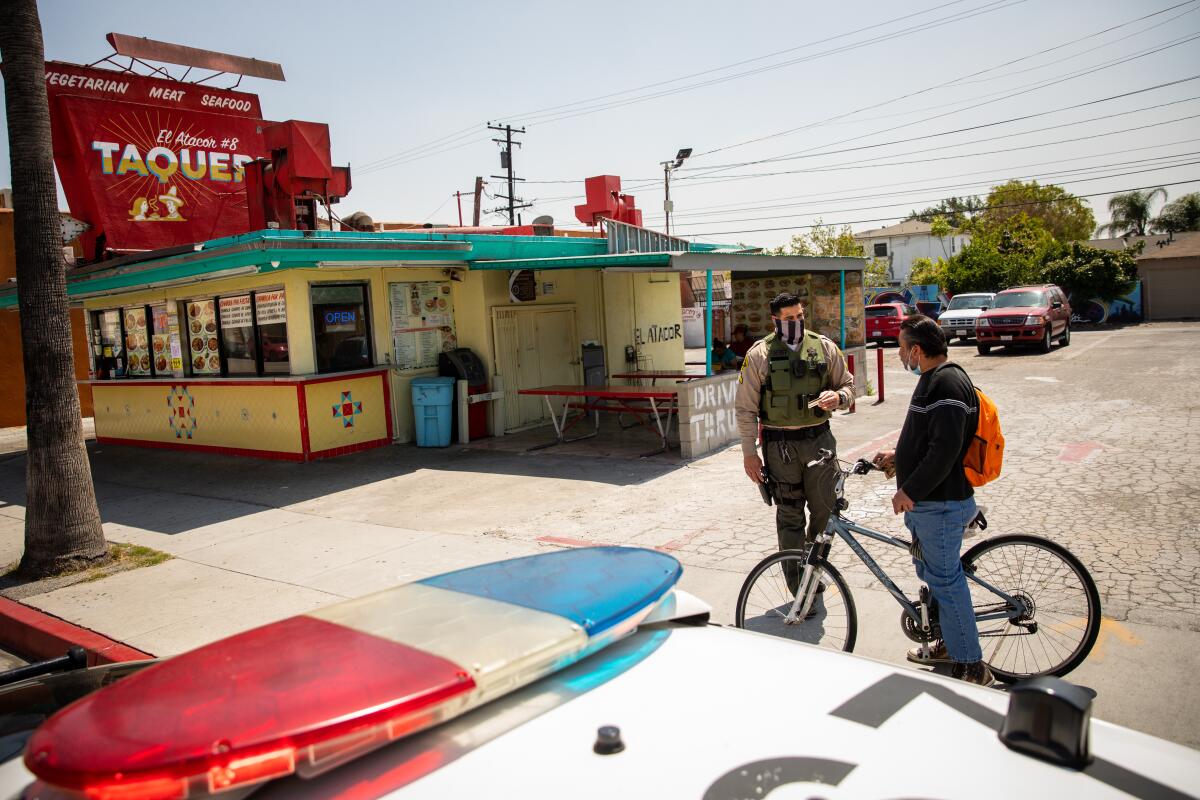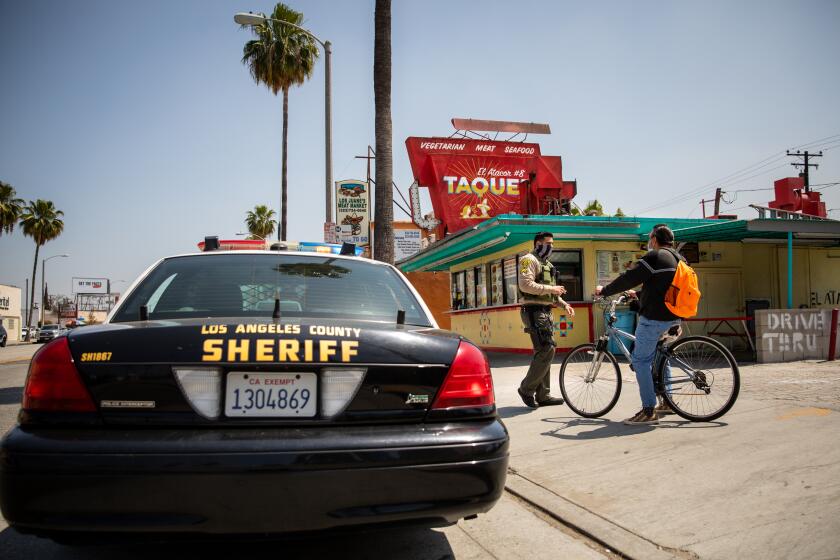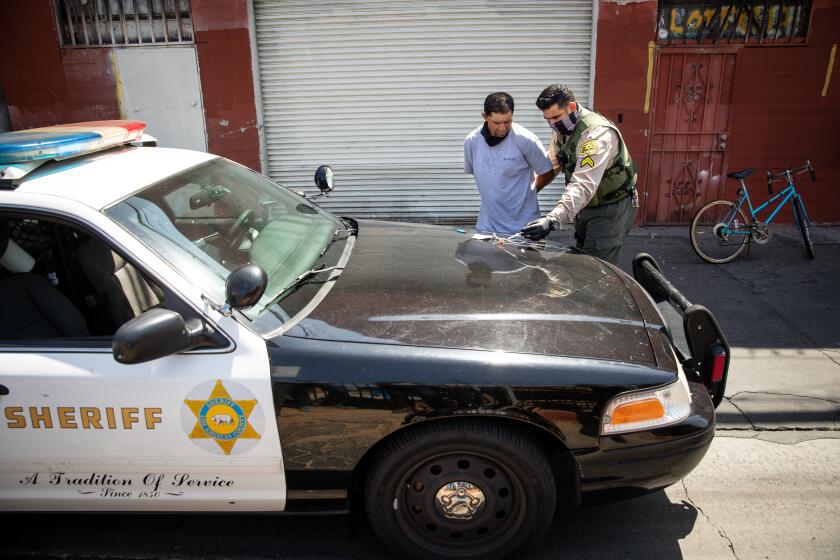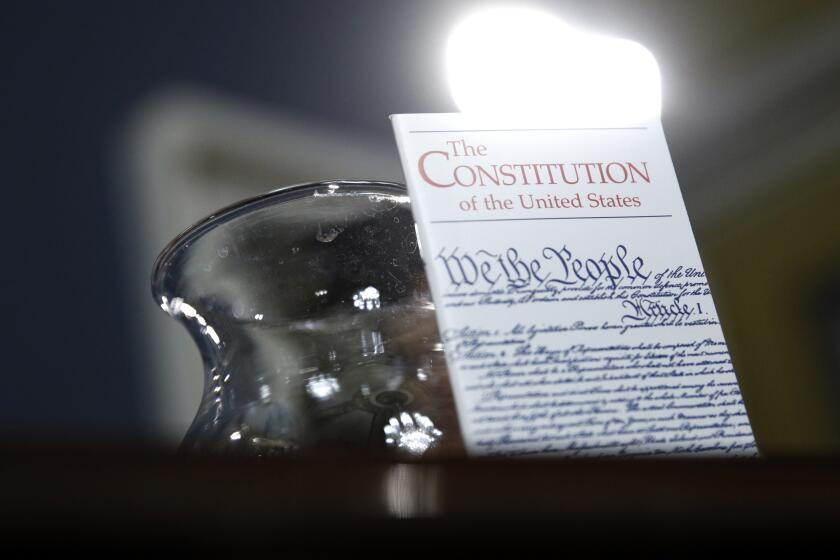Editorial: Where it’s unsafe and unjust to bicycle in California

- Share via
In some communities in California, the simple act of bicycling to work or pedaling around the neighborhood can be fraught with risk. There are few if any bike lanes or bike paths to separate cyclists from speeding cars. The streets may be full of cracks and potholes.
And riders, particularly Latino and Black men, can become targets of law enforcement officers, who use minor infractions — like riding on the sidewalk — as pretext to stop, question and search them. A recent Times investigation detailed how the Los Angeles County Sheriff’s Department routinely stops bicyclists in poorer communities with large nonwhite populations, and those riders were more likely to be searched or detained in the back of a patrol car.
In short, cyclists in certain Los Angeles County communities are treated like suspects and harassed by deputies just for trying to get across town on two wheels — which is exactly the kind of sustainable transportation that California has, in theory, embraced as a way to fight climate change.
In fact, state leaders attended the world summit in Glasgow, Scotland this week to tout the state’s progress in fighting climate change and get inspiration on how to do more. And for California, the “do more” part has to include slashing greenhouse gas emissions from transportation, which is the state’s largest source of planet-warming emissions.
California has programs to fund bike lanes and bike paths, along with safer sidewalks and streets, to make it easier for people to get around without a car. But the state and local governments are moving far too slowly, and there remain gross inequities in which communities have bicycle infrastructure and actively support cyclists, and which do not.
Instead of finding support for their carbon-free travel, cyclists in some communities face unsafe and unjust conditions. In East Los Angeles, only 1% of streets have bike lanes, meaning cyclists are expected to navigate crowded and often poorly maintained streets. Of course people are going to ride on the sidewalk, even if it’s prohibited, because it’s safer.
Yet that rational decision makes cyclists a target for law enforcement. Nearly a quarter of bike stops in East L.A. were for sidewalk violations, The Times reported. In Lynwood, where there are no bike lanes at all, sidewalk violations account for 16% of stops. In West Hollywood, which is predominantly white, more streets have bike lanes and the city allows bicyclists to ride on the sidewalk in areas with no bike lanes. Less than 1% of bike stops were initiated because of sidewalk violations.
The stop-and-search policy targeting Latino cyclists is abusive and bigoted and shows little crime-reduction value. It also demonstrates the need for stronger civilian oversight of the sheriff.
The failure to invest in bike infrastructure and to enact laws that better support cyclists has real-world consequences, beyond allowing law enforcement to profile riders and use minor bike infractions as cause to search a person or detain him in the back seat of a patrol car. That not only denies cyclists the freedom to ride without fear, but it makes it harder to persuade people to ride instead of drive.
The L.A. County Board of Supervisors has limited ability to stop the Sheriff’s Department from profiling cyclists, but they can make other fixes. Supervisors Janice Hahn and Hilda Solis said they want to reconsider the law that makes it illegal for bicyclists to ride on the sidewalk in the county’s unincorporated areas. That’s fine as an immediate accommodation. But it doesn’t resolve the fact that too many communities in L.A. County have little or no bike infrastructure. The supervisors should ensure that more transportation dollars are spent on making the streets safer for cyclists (and pedestrians.)
The lack of safe biking infrastructure sends a message that cyclists are not valued or welcomed — or worse, that traveling by bike is somehow cause for suspicion. That’s not only deeply unjust, it undermines the promises from state and local elected officials to take real action on climate change and create healthier sustainable communities.
More to Read
A cure for the common opinion
Get thought-provoking perspectives with our weekly newsletter.
You may occasionally receive promotional content from the Los Angeles Times.












